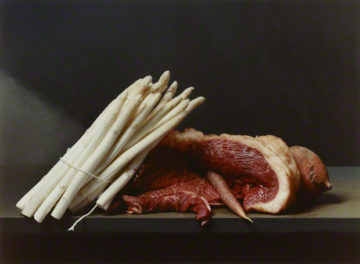This summer Friday Flights brought together over thirty artists and musicians at the Getty. As part of this series, we’ve been featuring playlists of songs that respond to the art in our summer exhibitions. Our final installment transports us to the dense, hyperreal megalopolis that is Tokyo with a playlist paired with the exhibition In Focus: Tokyo. This show brings together photographs that peer into localized worlds and private moments within one of the earth’s most frenzied cities, and offers a glimpse into the psychological identity of its denizens.

Picnic #34, 2005, Masato Seto. 16 15/16 x 21 7/16 inches. J. Paul Getty Museum. Purchased with funds provided by the Photographs Council. © Masato Seto
By listening to music that would have been flooding the malls and clubs of Tokyo in the 1990s and early 2000s—the time span of the exhibition’s photos—we open another window into the city. This playlist takes you from bubblegum pop and the synthpop, club, and rave scenes, to the far reaches of experimental noise and avant-garde music, demonstrating the wildly diverse creative energies that thrive in this city.
We invite you to bring your headphones to the gallery, pull this playlist up on your smartphone, and consider the music together with the photographs in the exhibition. And to join us next summer as Friday Flights returns with its live merging of art, music, and the creative process.
Wink, “Sabishii Nettaigyo”—Lonely Tropical Fish (1989)
This 80’s J-Pop duo rose out of Japan’s beauty contest and teen idol culture, but Wink distinguished themselves from the bubblegum acts with their signature deadpan faces and elaborate “Lolita” fashions. The band became such a phenomenon that a chain of stores selling Wink-inspired fashions opened in the Harajuku district, the epicenter of Tokyo street fashion and its many subcultures.
Pizzicato Five, “Baby Love Child”—This Year’s Girl (1991)
In the early ‘90s, Tower Records and HMV opened megastores in the Shibuya district, each with several floors offering cheap CDs of every genre of music. The result was the advent of Shibuya-kei, a new Japanese music genre that fused jazz, Bossa Nova, and the stylings of Serge Gainsbourg with electronic synthpop. Largely inspired by the advent of sampling, Pizzicato Five were pioneers of the Shibuya-kei style, which creates the perfect kaleidoscopic backdrop to Tokyo through layered beats and moody vocals.
Boredoms, “Telehorse Uma”—Pop Tatari (1992)
Although hailing from Osaka, Boredoms are radical noise rockers who made a big impact on the artistic identity of both Japanese and American youth culture. Psychic explosions and incomprehensible chaos make up one of the most far-out and pointedly strange releases ever to be supported by a major record label. After the release of Pop Tatari on Warner Music in Japan, Boredoms went on an international tour opening for Sonic Youth and Nirvana. The aggressive and deconstructed impulses within their liberating sound stands in stark contrast to the rigid conventions of mainstream Japanese society.
Shonen Knife, “I Am A Cat”—Let’s Knife (1992)
Shonen Knife are an all-girl band that created one of Japan’s quirkiest and fun rock albums, Let’s Knife. Starting out as early as 1981, Shonen Knife put their obsessions with ‘60s girl groups and the Ramones together to create a sound that was right at home with the early ‘90s indie and riot grrl sounds. They created a new voice for girls by championing a DIY punk ethos and an alternative brand of cute that didn’t rely on the prevailing saccharine tropes of J-Pop, but rather hilariously silly but earnest lyrics.
Cornelius, “Free Fall”—Fantasma (1997)
Cornelius is a musician and producer whose landmark album Fantasma is the epitome of the mature Shibuya-kei style, introduced earlier with Pizzicato Five. Here the same blend of jazz and synthpop achieves a more atmospheric, wall-of-noise wash but doesn’t fall back on typical dance music tropes or cliche retromania. In “Free Fall,” the fusion of digital sounds reaches a sparkle and moves at a fast clip, while the mantra-like vocals are languid and dreamy. This dynamic between the frenetic and the languid channels images of crowds rushing through one of Tokyo’s mega-intersections, a scene both chaotic and mundane.
Denki Groove, “Nothing’s Gonna Change”—VOXXX (2000)
By the 2000s, underground rave culture that thrived on techno and trance, and its aesthetic synthesis with cyberpunk anime, had burst through to the mainstream and begun to meld with bouncy J-Pop. Denki Groove had several chart-topping hits that mastered this blend. They created their sound in the characteristically Japanese fashion of intensely focusing on a single artistic idol, in this case German electronic music pioneers Kraftwerk. Here the simple and repetitive trademark Kraftwerkian fascination with technology manifests into the disaffected mantra of “nothing’s gonna change,” echoing the frustration and disillusionment that plagued Japan’s youth during the cultural and economic transitions of this period.
Boris, “Ibitsu”—Akuma no Uta (2003)
On the opposite side of the spectrum from Denki Groove and its popification of their idol Kraftwerk, experimental band Boris made their mark by eschewing conventional sound and cleverly using a wide range of influences and genres. Boris has created over 20 studio albums since 1997 that traverse styles from psychedelic stoner rock and sludgy doom metal to ambient and avant-garde noise. This record, which is filled with ‘70s-style metal and heavy rock sounds, might recall anyone but soft-spoken, melancholic English folk singer Nick Drake, whose record cover for Bryter Layter was recreated for this album. The cover shows Boris’s Takeshi holding a double-neck electric guitar, instead of the acoustic Drake holds in the original, and the album was also engineered to be exactly 39 minutes to match Bryter Layter’s length.
YMCK, “Rain”—Family Genesis (2008)
YMCK is an example of chiptune, a genre of synthpop music that is made using only the 8-bit chips from vintage computers and Nintendo game consoles. While they create music tonally indistinguishable from the soundscapes of “Super Mario Brothers” or “The Legend of Zelda”, YMCK takes cues from jazz composition to create complex songs that, while inextricably linked to the computer, give the sense that they’d sound great on regular instruments. Perhaps more than any of the artists on this list, YMCK embraces and thrives on nostalgia for obsolete technology, and inspires us to consider what this means in the midst of our ubiquitous and rapidly changing digital landscape.
Shugo Tokumaru, “Rum Hee”—Port Entropy (2010)
Tokumaru is known for creating every sound of his deeply intricate music entirely himself, alone in his apartment, with just a laptop and his personal collection of hundreds of instruments of all kinds, from toys to traditional Japanese instruments. Tokumaru creates songs that seem to have hundreds of minute layers that, here in “Rum Hee,” range from a melodica and glockenspiel, to bird whistles, kazoos, and sleighbells. Writing in intense fits of creativity, often forgetting to sleep or eat for days at a time, he takes all his lyrics from his own dream journals. From this private world comes sweet, joyful music full of positive whimsy and childlike wonder. Tokumaru’s sound echoes the energy and intricacy of the awe-inspiring city of Tokyo, while also bringing us into his personalized intimate world. Much like the exhibition’s photographs, he gives us a glimpse into some of the fascinations of Tokyo’s youth, which are both digital and retro, juvenile and sophisticated.
Ryoji Ikeda, “the transfinite”—installation at the Park Avenue Armory (2011)
Ryoji Ikeda is Japan’s leading electronic composer whose work pushes music beyond the boundaries of sound into a visual manifestation. Ikeda’s innovative work distills avant-garde minimal music and sound art into a transformative installation that has to be seen to be believed, so be sure to look and listen to this one! Commissioned for Manhattan’s enormous historic bunker the Park Avenue Armory, Ikeda’s environmental installation “the transfinite” carries a fascinating relationship to Tokyo’s Hachiko Square, the world’s busiest intersection, the road nearly covered with the stripes of crosswalks, and banked on all sides by flickering neon lights.




Comments on this post are now closed.